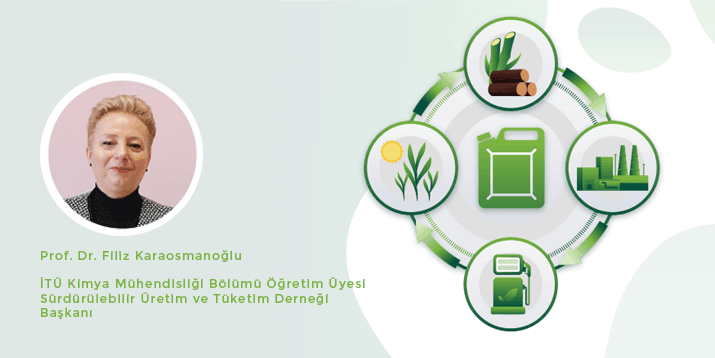The chemical industry, which began with woodworking and has evolved to the present day, relies on inputs such as coal, oil, natural gas, ores, air, water, plant and animal resources, and waste. A wide variety of chemicals serve as inputs in the form of products or semi-products to other sectors, while products that reach both industry and consumers are ubiquitous in our lives. Lubricating oil chemistry and lubricant production hold a unique position in both production and consumption due to their distinct characteristics. A vast sector for raw materials, base oils, additives, and packaging generates gain and employment. Each lubricant and grease carries both a financial cost and an environmental cost. As already known, we must decrease the environmental cost and reduce the impact of these three primary issues to the lowest level technically possible: biodiversity loss, environmental pollution, and climate change. We must lower the overall cost to the planet caused by packaged lubricants throughout their life cycle, in other words, in production-transportation-consumption and waste oil management.
Every lubricant should perform optimally in its intended application. It must not only be compatible with the equipment but also suit the inherent properties of the lubricant itself. When selecting an oil, “Biodegradability” and “Ecotoxicological Effects” are crucial considerations, especially for applications involving direct contact with soil and water. In this context, the quality of “Biobased Products” within the bioeconomy is becoming increasingly important for lubricant oils.
For biobased products, the United States Department of Agriculture (USDA) runs the BioPreferred Program. This program aims to increase the purchase and use of biobased products by creating new jobs and developing new “BioPreferred Products”. The European Union (EU) prioritizes biobased products through the EU Green Deal and its 2050 targets. The USDA classifies plant-based base oils and biolubricants as “BioPreferred Products”. The Circular Bio-based Europe Joint Undertaking (CBEJU), a collaboration between the EU and the Bio-based Industries Consortium (BIC), has the objective to accelerate the innovation and the market uptake of biobased innovative solutions while ensuring their environmental performance as well as economic and social benefits.
In April 2023, the American Petroleum Institute (API) introduced a new methodology for calculating the product carbon footprint (PCF) through the Life Cycle Assessment (LCA) study of lubricants. At the same time, the Union of the European Lubricants Industry (UEIL) and the Technical Association of the European Lubricants Industry (ATIEL) jointly developed the methodology. For LCA and PCF, the biogenic carbon of biolubricants has a high advantage.
In line with these developments, the share of biolubricants in the lubricant market is increasing, with new brands reaching consumers through the product ranges of both local and global manufacturers. These products, often referred to as “Biolubricants” under the broader category of “Environmentally Friendly Lubricating Oils”, primarily use vegetable and animal oils, as well as other biomass sources, as raw materials. These renewable resources, or renewable hydrocarbons, are processed through various conversion methods. While vegetable oil derivatives are predominantly used as biobase oils, research and development in bioadditives are also advancing.
Biolubricants offer rapid biodegradation, low ecotoxicity, renewability, a high viscosity index, and a low friction coefficient. These advantages contribute to longer equipment life and make biolubricants environmentally, climate, and biodiversity-friendly, with superior lubrication properties. However, biolubricants also have some disadvantages compared to petroleum-based and synthetic lubricating oils, such as a lower flash point, fire potential, limited operating temperature range, reduced fluidity in cold conditions, structural decomposition, and incompatibility with certain materials. Despite these drawbacks, biolubricants have undeniable advantages in applications where environmental, climate, and biodiversity considerations are paramount, such as in water, forest, mountain, and mining operations. Examples include river, coastal, and inland sea navigation, construction machinery, slope maintenance equipment, snowmobiles, and forestry and agricultural machinery. The primary motivation for using biolubricants is to protect the present and future of our planet. Imagine the benefits if biolubricants were widely used in the national parks, lakes, mountains, and mines of our beautiful country. Biolubricants would perfectly complement our green and blue landscapes.
There has been a recent development. As of September 2, 2024, the Scientific and Technological Research Council of Türkiye Marmara Research Center (TÜBİTAK MAM), in collaboration with the Ministry of Environment, Urbanization, and Climate Change, has launched the “Turkish Environmental Labelling System (TÇES) Dissemination Project”. This initiative aims to nationalize environmentally friendly lubricant products by defining national standards. It’s a significant step towards promoting sustainable options, and it’s worth keeping an eye on.
It would be good to follow the first and only 10th Istanbul Carbon Summit, where our energy and chemical sectors have taken a strong stance. We are expecting you, our stakeholders, to our ITU’s registered green Ayazağa Campus on April 14-15, 2025 for “Sustainable Solutions on the Path to Decarbonization and the Power of Green Money”, for Türkiye.




